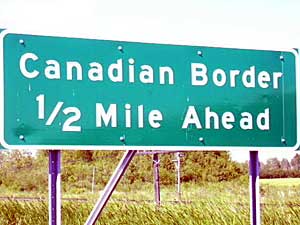|
Photos
More from MPR
Resources
Your Voice
|
Beefing up U.S. border security
August 7, 2003
 |
| The U.S.-Canada border in northern Minnesota. The Border Patrol in that area is about to gain some 60 new agents and new technologies to help prevent illegal border crossing. (MPR Photo/Bob Reha) |
Warroad, Minn. — Glen Schroeder is in charge of patrolling 900 miles of the U.S.-Canadian border. Schroeder is the chief patrol agent of the Border Patrol's Grand Forks sector. The sector also includes Lake Superior, and the west shore of Lake Michigan. Schroeder says the agency has 60 vacancies to fill. "We're not going out on the street and and hiring people for these positions," says Schroeder. "These are experienced agents who have, probably, anywhere from three to 10 years of experience on the southwest border."
Schroeder says the transfer of those 60 agents is important -- it provides resources along the northern border to comply with the Patriot Act.
"Rather than putting one officer out for 100 or 150 miles of border, and having that agent out there at two in the morning by himself or herself, we will have people that are there for backup. They can back each other up, they can work together, that's a big plus," says Schroeder.
 | |||
The deployment is more than adding agents. New equipment, planes, boats and high tech movement sensors are also coming.
Ron Bastyr is the agent in charge at the Warroad station in northern Minnesota, on the shores of Lake of the Woods.
"Some of the technology that's been explained to us, they can differentiate with these different sensors if it's a human walking, if it's an animal walking," says Bastyr. "It's pretty high-tech stuff that they're looking at putting up on this northern border."
Bastyr says the Warroad office is responsible for 144 miles of the border. He's excited by some of the new equipment his office will receive. It includes powerful cameras that can monitor five-mile stretches of the border.
"They haven't given us a time frame, but there's been engineers up here looking over the area and seeing what kind of challenge it would take to actually install these cameras and get them operational on the border," says Bastyr. "That way you wouldn't have to have someone sitting on the border. Everything would be run with remote control cameras, and we could have a monitoring office and we could dispatch out of there."
 | |||
Bastyr can't say how many new agents will be assigned to the Warroad office. He says a new substation might open in Baudette. Bastyr says more agents will increase the visibility of the Border Patrol. The more visible agents are, the more it works as a deterrent.
Scott Robinson patrols the back roads between Roseau and Warroad, keeping his eye out for people who might try to cross the border illegally. He stops his truck and scans the area with field glasses. It's a false alarm. Robinson jokes his eyesight is failing, because he mistook some cattle for a car.
Robinson's been with the Border Patrol for 15 years, the last 11 of them in the Warroad area. Robinson welcomes the news that reinforcements are on the way.
"We cover such a large area of square miles from Warroad to the west," says Robinson. "Also Lake of the Woods, and the {east branch of the Warroad} river -- that it just gives us better coverage."
 | |||
Robinson says the influx of people and personnel are part of the response to the Sept. 11 terrorist attacks.
"It has definitely given attention to the northern border. It's given attention to the politicians and the people who fund the agency," says Robinson. "It definitely has given us a lot more tools."
Border Patrol officials say, by the end of this year, approximately 1,000 Border Patrol agents will be permanently assigned to the northern border.
|
News Headlines
|
Related Subjects
|
